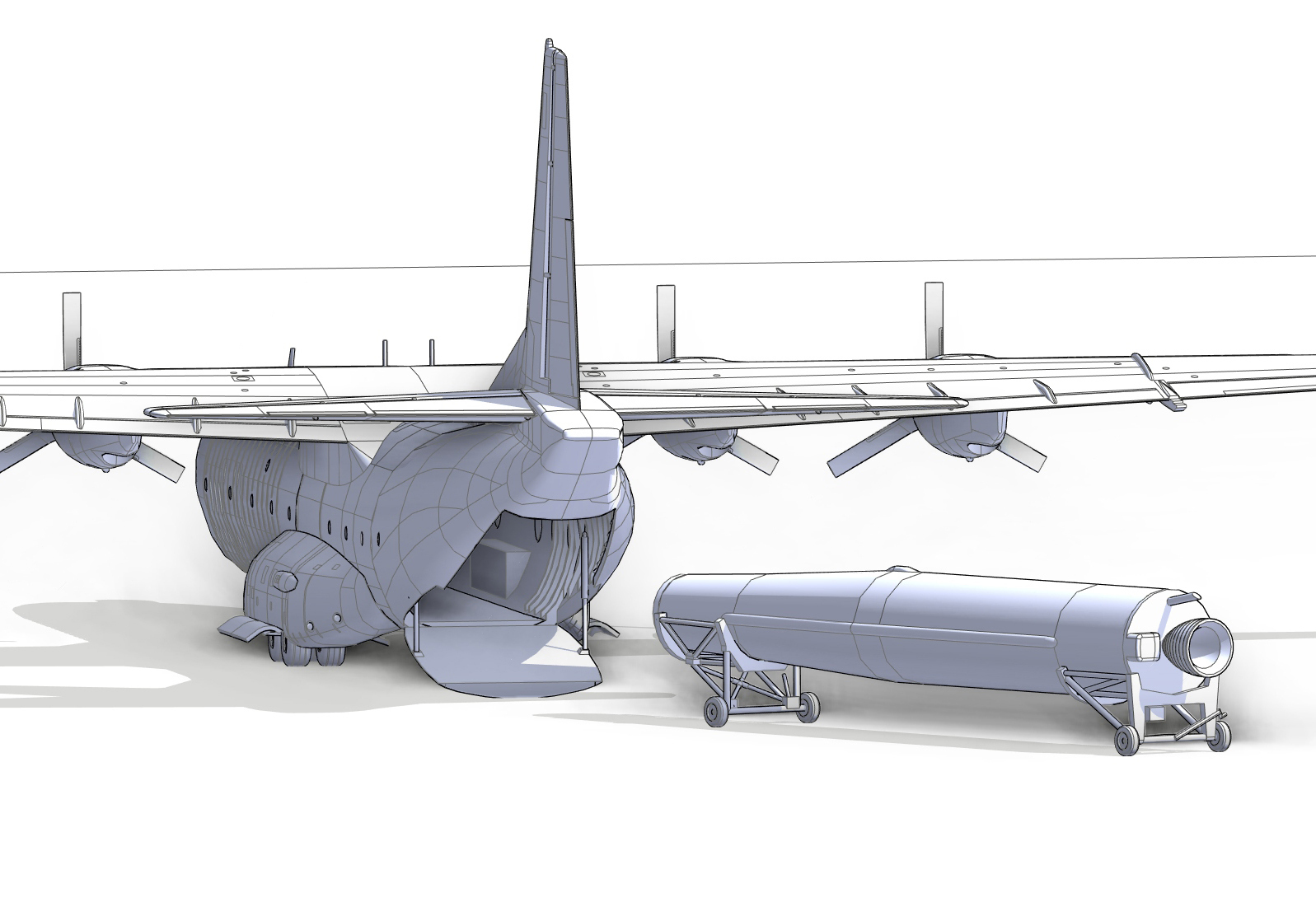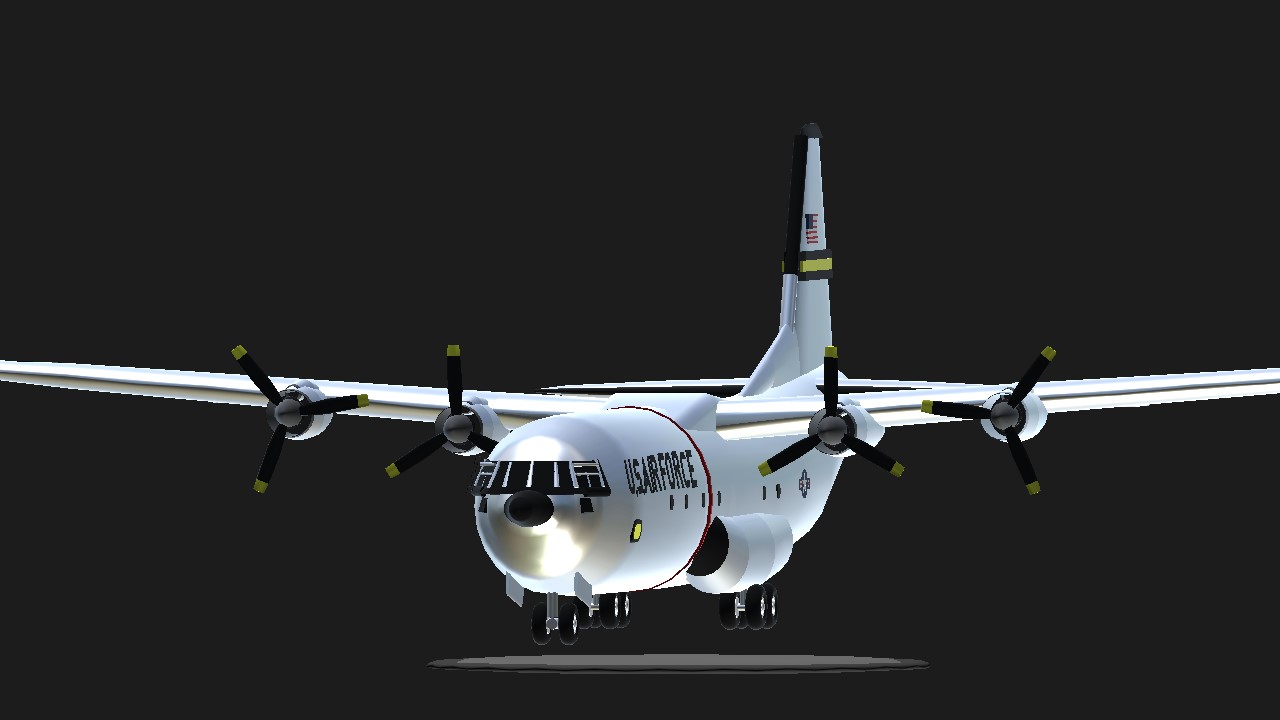C 133 Aircraft - By 1961 managers within NASA began thinking about modes of transportation to ensure rapid delivery of upper Saturn stages, beginning with the S-IV. The size of the S-IV ruled out delivery to the Cape by rail or road.
As the lead center of launch vehicle development, MSFC let a contract in 1960 to the Douglas Aircraft Corporation to determine the feasibility of air transport. A Douglas assessment team spent several months on the project and came up with a proposal that envisioned a "piggyback" concept that used an Air Force C-133 transport.
C 133 Aircraft

Design studies included pictures of the rocket stage positioned above the C-133 and perched atop streamlined fairings. Because the stage was exposed to the passing air stream, planners expected to fit the stage with a streamlined nose cone, with vertical stabilizers at the rear to enhance its aerodynamic qualities in transit.
C- Cargomaster
A high-mounted wing, external blister fairings on each side for the landing gear, and rear-loading and side-loading doors ensured that access to, and the volume of, the large cargo compartment were not compromised by these structures.
The C-133 could fly the equivalent of 22 loaded railroad boxcars nonstop between Los Angeles, Calif., and New York for about 5 cents per ton per mile (907 kilograms per 1.6 kilometers). It carried fully assembled tanks and transported the Douglas-built Thor intermediate-range ballistic missiles.
Douglas built and delivered the last Cargomasters in 1961. NASA used Cargomasters to drop-test early space capsules and to transport a variety of space products. Douglas built 50 Cargomasters, but after the C-133, Douglas did not build transports specifically for the military for another 10 years.

From March into May of 1966 the Buddhist chaplains of the Army of the Republic of Vietnam's (ARVN) crack 1st Infantry Division incited their troops to open mutiny. To suppress the mutiny, commanders decided to send 1st Troop (M41A3), 5th ARVN Cav from Xuan Loc in In Corps to Da Nang.
The only way to get it there in time was to airlift it, so they called upon Military Assistance Command, Vietnam (MACV) for help. Senior Advisor, Republic of Vietnam (RVNAF) Armor Command, Colonel Raymond R. Battreall received instructions from MAC 53 (MG William De Puy, later CG, TRADOC) to supervise the loading of 1/5 Troop aboard four USAF C-133s at Tan
Son Nhut Airbase. The C-133's internal dimensions could accommodate two M41s if they could be gotten inside without tearing the plane apart and if the load would remain balanced. There would be only %-inch clearance on each side.
Suggestions from other sources ran the gamut from airplanes to gliders to lighter-than-air vehicles. One proposal envisioned the use of a blimp, which would putter along from California to Florida with a swaying S-IV stage slung underneath.
As late as 1963 serious thought was given to resurrecting a modern successor to the prewar dirigible, with an interior cargo hold to carry rocket stages. The first C-133A arrived at Travis on Oct. 17, 1958 and was dubbed the "State of California" and was assigned to the 84th Air Transport Squadron of the 1501st Air Transport Wing.

The last Cargomaster, a C-133B departed Travis on July 30, 1971 for the Davis-Monthan Air Force Base in Arizona. Operation BLUE LIGHT, in late 1965, was the first combat operational test of the C-141. A total of 88 C-141 sorties, 126 C-133 sorties, and 11 C-124 sorties delivered an infantry brigade directly from Hawaii to Pleiku, South Vietnam, where the Viet Cong were massing for a major attack.
N199AB as it was re-dubbed on Dec. 6, 1975 was purchased by Maurice Carlson for the Cargomaster Corporation and was flown to Alaska to haul cargo for the Alaskan Pipeline. Forty-eight years after its departure from Travis, it returned to a base that it called home for the last time.
The Alaskan sky was dark and overcast and Terry pulled the collar up on his brown leather jacket to keep the chill out. This was going to be a big day for him. He was far from home.
A little anxious, a little excited, and one could say even a little nervous. His steps were heavy as he walked out on the barren flight line and thought about what he might be getting into.
What could he say? What would he do? The questions went round and round in his head, a chaotic jumble of words, but before he could grasp his thoughts and get a handle on things, he saw her.

From that timeless moment on, the Travis Heritage Center, and the men, women and families of the 84th Military Airlift Squadron devoted their time and efforts to bring the C-133 "Cargomaster" 56-1999, home. In no time, the arrangements and the funding for the long trip from Alaska to Travis were made and in August 2008, the last flying C-133 touched down at the 2008 Travis Air Expo.
Terry Juran, the museum director at the time, was there to greet her as well, and he had the sole honor of being the last crew chief to block a C-133. ABOUT THIS SITE | TERMS OF USE |
PRIVACY POLICY | CONTACT US Copyright © 2023 Airplanes-Online.com The C-133 was the USAF's only production turboprop-powered strategic airlifter, entering service shortly after Lockheed's better known C-130 Hercules, which was known as a tactical airlifter. It provided airlift services in a wide range of applications, being replaced by the C-5 Galaxy in the early 1970s.
By the time the last aircraft was ready to go, the first one had returned from Da Nang for a second load. Each plane flew two sorties, and one flew a third to deliver the seventeenth tank.
These C-133s supported the combat-operational airlift of tanks in the history of warfare. Units had flown empty tanks once around the airfield to prove it could be done on Strategic A&Y corps (STRAC, FORSCOM's predecessor) mobility exercises;

and aircraft had flown empty tanks over oceans when the delivery priority was high enough. But never before had combat-loaded tanks flown with crews ready to go into action upon arrival at the other end. That is just what the 1/5 ARVN Cav did.
The M41s shown on TV clearing the streets of Da Nang of mutinous elements were theirs. As a result of its design, the C-133 was capable of carrying large payloads that included transporting the Atlas, Titan and Minuteman ballistic missiles.
The C-133 would also do work for NASA transporting Atlas, Saturn and Titan rockets to Cape Canaveral as the launch booster for the Gemini, Mercury and then the Apollo space programs. The aircraft was flown only at Travis and Dover Air Force Bases for the 1501st (later the 60 MAW) and 1607th (later the 436 MAW) Air Transport Wings.
Three squadrons flew the aircraft that included the 1st, 39th and 84th Air Transport Squadron (later military airlift squadrons). For 13 years the C-133 served our Air Force as the first wide-body cargo aircraft. Only 50 of these magnificent aircraft were ever made and unfortunately only seven remain in existence.
They courageously served our Air Force from 1958 to 1971 until they were replaced by the C-141 "Starlifter" and later overshadowed by the C-5 "Galaxy" and C-17 "Globemaster III". NASA referred to her as the first step into space as she carried booster engines for the Mercury Gemini Space Program, and on several occasions she carried the Apollo space capsule.

More than anything else though, the C-133 was the airplane of the 84th MAS stationed at Travis. The Cargomaster was the largest turboprop transport to be used by the United States Air Force. At over 157 feet long with a wingspan of 179 feet, plus its four Pratt and Whitney T34-P-7WA engines rated at 6,500 horsepower each, the aircraft was able to do what was considered impossible at the time.
There were only 50 Cargomasters produced; 35 "A Models" and 15 "B Models." It was the first aircraft in Air Force history to go directly into production without any prototypes. The C-133 was for many years the only USAF aircraft capable of hauling very large or very heavy cargo.
The C-133 was originally a 10,000-hour airframe that had been life-extended to 19,000 hours. Severe vibration had caused critical stress corrosion of the airframes to the point that the aircraft was beyond economic operation any longer.
The Air Force managed to keep as many of the C-133 fleet in service as possible until the C-5 finally entered squadron service. She stood there all alone. She was weathered, cold and lost. She was pushing more than 17,000 hours of flight time and her days of flying were now numbered.
She was missing her markings and looked tired, but there was no mistaking that she was the one. Terry was speechless. He approached her slowly, put his hand out to greet her and like destiny and knew without a doubt, that their lives would never be the same again.
On Saturday, 15 Mar 2010, the 84th MAS celebrated their reunion at the Travis Heritage Center where their honored guest was, their long lost love, the C-133 "Cargomaster". This magnificent aircraft, tail number 56-1999, which flew out of Travis only from February to November 1960, was the main attraction for this occasion.
Also on that day, the Travis Air Museum presented their newest display dedicated to the men and women who sacrificed, served and supported this beautiful aircraft and to those who donated funds to bring this beauty home.
The 84th Squadron moved to Travis AFB in 1953, where it was equipped with long range C-124 "Globemaster II" intercontinental transports. The unit flew worldwide strategic transport missions under the Western Transport Air Force. It was re-equipped with the C-133B "Cargomaster" very heavy strategic transport aircraft in 1958, and continued worldwide transport operations until July 1971 when the C-133s were retired.
c 133 aircraft accidents, c 17 globemaster, c 133 cargomaster problems, c 133 cargomaster cockpit, douglas c 133 cargomaster, c 133a, c133 aircraft photos, c 133 first flight